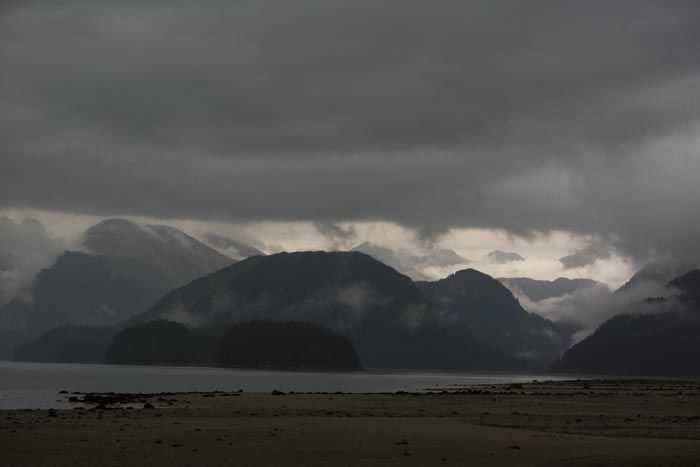National Geographic Sea Lion pulled into Dundas Bay early this morning. The forecast shifted, making for grey on grey day with shades of dark green. We could see the tall foot hills of the Fairweather Mountain Range in the distance, shrouded in mist and low clouds, as the rain came and went in periodic squalls across the ship’s bow.
In 1794, Captain George Vancouver arrived at the entrance to what is now Glacier Bay. At that time the Bay was filled with glacier ice that extended to within five miles of the mouth of the bay. During the last 220 years, the ice has retreated 65 miles relieving the land of its massive weight, allowing for isostatic rebound to bring 19 to 22 feet of land rise to the entire area.
National Geographic Sea Lion was anchored just inside the entrance to Dundas Bay and would be spending our day exploring both land and sea. Due the Wilderness Protection of this National Park we were regulated to precise group sizes and distances between arrival and departure from land to ship and back!
Hikers were dropped off in two locations and each group made their way across a large series of mud and sand flats. Our goal was to enter the newly growing forests and hopefully see who else might call this place home. Because of the protected status of Glacier Bay National Park, we were walking through an old-growth, ever-changing and new Northwest temperate forest, less than 200 years old! The outer meadows were carpeted with wildflowers. Yarrow, beach pea, two species of paintbrush, wild strawberry, nagoon berry, and many members of the carrot family grew all around us! As we walked, we stopped often to eat berries as we moved into the forest. As we walked under the curtain of Sitka alder and Sitka spruce, we entered a quiet, damp world beginning its seasonal change towards fall and winter. Gazing down we found the first mushrooms of the fall. Some were just poking out of the moss and soil representing the fruiting bodies of the enormous mycelium deep under-ground.
Our walk along bear trails led us out of the forest onto another series of meadows that led to one of the longest perennial bear track trails many of the staff had ever seen. It was at least a half-mile-long series of constantly used tracks, present so long that small stands of Sitka alder had grown up very near the trail, almost obscuring it as the bears moved along their well-used route.
After warming up with lunch our groups returned to opposite activities. The hikers went for Zodiac rides and those who had been on the waters of Dundas Bay returned to the shore to explore the land. Those in Zodiacs were buffeted by heavy rain, wind and a healthy chop…their reward was a very relaxed Black bear foraging along the shoreline. As the zodiacs rolled in four-foot seas and rain everyone who braved the ride got wonderful views of a Black bear taking care of the business of finding food.
Hikers returned to the shore, the meadows and the forest to watch as life in Dundas Bay continued as it has since the ice retreated a short time ago…the rain continues to fall, sunny days come and go, the land continues to rise slowly from the release of a huge glacial ice blanket and we have, just for a moment, spent a day looking at a small part of a national treasure, called Glacier Bay National Park.







